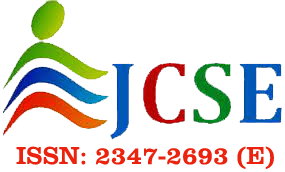Analysis of Facial Expressions for Predicting Student’s Learning Level
Vidyadhari S.1 , Dhirendra S. Mishra2
Section:Research Paper, Product Type: Journal Paper
Volume-8 ,
Issue-2 , Page no. 87-92, Feb-2020
CrossRef-DOI: https://doi.org/10.26438/ijcse/v8i2.8792
Online published on Feb 28, 2020
Copyright © Vidyadhari S., Dhirendra S. Mishra . This is an open access article distributed under the Creative Commons Attribution License, which permits unrestricted use, distribution, and reproduction in any medium, provided the original work is properly cited.
View this paper at Google Scholar | DPI Digital Library
How to Cite this Paper
- IEEE Citation
- MLA Citation
- APA Citation
- BibTex Citation
- RIS Citation
IEEE Citation
IEEE Style Citation: Vidyadhari S., Dhirendra S. Mishra, “Analysis of Facial Expressions for Predicting Student’s Learning Level,” International Journal of Computer Sciences and Engineering, Vol.8, Issue.2, pp.87-92, 2020.
MLA Citation
MLA Style Citation: Vidyadhari S., Dhirendra S. Mishra "Analysis of Facial Expressions for Predicting Student’s Learning Level." International Journal of Computer Sciences and Engineering 8.2 (2020): 87-92.
APA Citation
APA Style Citation: Vidyadhari S., Dhirendra S. Mishra, (2020). Analysis of Facial Expressions for Predicting Student’s Learning Level. International Journal of Computer Sciences and Engineering, 8(2), 87-92.
BibTex Citation
BibTex Style Citation:
@article{S._2020,
author = {Vidyadhari S., Dhirendra S. Mishra},
title = {Analysis of Facial Expressions for Predicting Student’s Learning Level},
journal = {International Journal of Computer Sciences and Engineering},
issue_date = {2 2020},
volume = {8},
Issue = {2},
month = {2},
year = {2020},
issn = {2347-2693},
pages = {87-92},
url = {https://www.ijcseonline.org/full_paper_view.php?paper_id=5037},
doi = {https://doi.org/10.26438/ijcse/v8i2.8792}
publisher = {IJCSE, Indore, INDIA},
}
RIS Citation
RIS Style Citation:
TY - JOUR
DO = {https://doi.org/10.26438/ijcse/v8i2.8792}
UR - https://www.ijcseonline.org/full_paper_view.php?paper_id=5037
TI - Analysis of Facial Expressions for Predicting Student’s Learning Level
T2 - International Journal of Computer Sciences and Engineering
AU - Vidyadhari S., Dhirendra S. Mishra
PY - 2020
DA - 2020/02/28
PB - IJCSE, Indore, INDIA
SP - 87-92
IS - 2
VL - 8
SN - 2347-2693
ER -
| |
|
|
| 382 | 475 downloads | 220 downloads |
Abstract
In today’s scenario, there is
an explosion
of knowledge and the context of what is learnt and how it is learnt by the
students become very important to understand. Student needs to develop their
higher order thinking skills which would help them understand and apply
concepts in the right manner. This research work specifically focuses on
emotion
detection of the
students by
analysing their facial expressions while they are answering a set of questions asked by
an instructor for different subjects. The aim is to identify the cognitive learning level of the Bloom’s Taxonomy
and map the emotions set to each learning level. This is achieved by capturing
the emotions of students from an emotion classifier based on CNN (Convolutional
Neural Networks) and further classifying them using various classification
algorithms which in turn predicts the Accuracy of the proposed system.
Key-Words / Index Term
Biometrics, Emotions, Cognitive learning level
References
[1]
Bloom, B. S.; Engelhart,
M. D.; Furst, E. J.; Hill, W. H.; Krathwohl, D. R. (1956). Taxonomy
of educational objectives: The classification of educational goals. Handbook I:
Cognitive domain. New York: David McKay Company.
[2]
Shane, Harold G. (1981).
"Significant writings that have influenced the curriculum: 1906-1981". Phi
Delta Kappan. 62 (5): 311–314.
[3]
Krathwohl, David R. (2002).
"A revision of Bloom`s taxonomy: An overview".
[4]
Anderson, Lorin W.; Krathwohl, David R., eds.
(2001). A taxonomy for learning, teaching, and assessing: 5. BJ Jansen, D
Booth, B Smith (2009) Using
the taxonomy of cognitive learning to model online searching, Information Processing
& Management 45 (6), 643-663
[5]
Anderson LW, Krathwohl
DR. A taxonomy for learning, teaching, and assessing: a revision of
Bloom’s taxonomy of educational objectives. New YorkNY: Longmans; 2001.
[6]
Alison Cullinane, Bloom’s
Taxonomy and its Use in Classroom Assessment, National Centre for Excellence in
Mathematics and Science Teaching and Learning, Resource & Research Guides
Vol. 1 #13 2009-10
[7]
Octavio Arriaga, Paul G. Pl¨oger,
Matias Valdenegro Real-time Convolutional Neural Networks for Emotion and
Gender Classification
[8]
Monika Dubey, Prof. Lokesh
Singh, Automatic Emotion Recognition Using Facial Expression: A Review, IRJET,
Feb 2016
[9]
Byoung Chul Ko, A Brief Review
of Facial Emotion Recognition Based on Visual Information, Jan 2018
[10] Octavio Arriaga, Paul G. Pl¨oger, Matias Valdenegro Real-time Convolutional
Neural Networks for Emotion and Gender Classification, ICRA 2018
[11] An empirical study on assessment of co attainment for a diploma
course, IJECET, IAEME, Vol 6, Issue 2, Feb 2015, pp. 06-12
[12] Student performance using Bloom’s cognition levels: A Case Study, H
R Bhagyalakshmi, D Seshachalam, Journal of Engineering Education Transformations,
Special Issue: Jan. 2015, eISSN 2394-1707
[13] Evaluation of Final Examination Papers in Engineering: A Case Study
using Bloom’s Taxonomy, Arthur James Swart, Member, IEEE
[14] Bloom`s Taxonomy: Improving Assessment and Teaching-Learning
Process, Muhammad Tufail Chandio, Saima Murtaza Pandhiani, Rabia Iqbal, Journal
of Education and Educational Development, Jan 2017
[15] Facial Expression Recognition Using
Static Facial Images, G.Sowmiya , V. Kumutha, Section: Research
Paper, Product Type: Isroset-Journal
Vol.6 , Issue.2 , pp.72-75, Apr-2018
[16] Neural Network through Face
Recognition, A.K.Gupta 1 , S.Gupta, Section:Research
Paper, Product Type: Isroset-Journal
Vol.6 , Issue.2 , pp.38-40, Apr-2018
[17]
Image
Merging in Transform Domain S. Jadav1* , P. Rawool2 , V. Shah3, IJSRNSC
Volume-5, Issue-1, April- 2017
[18] A Philosophical Review On Different Face Recognition
Techniques, D.
Venkat Ravi Kumar, K. Raja
Sravan Kumar
[19]
INTERNATIONAL JOURNAL OF COMPUTER SCIENCES AND ENGINEERING 6(7):929-933 · July
2018
